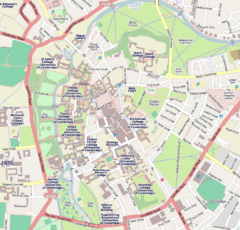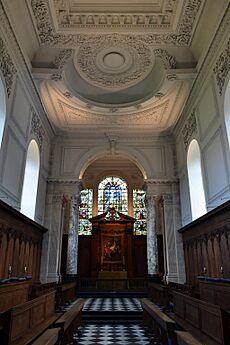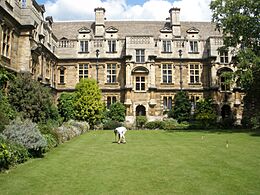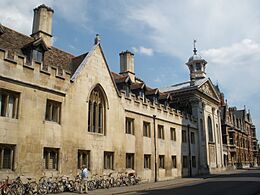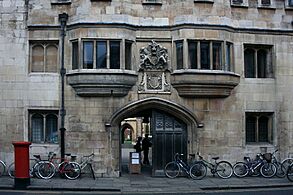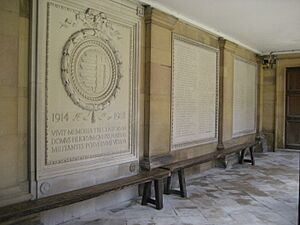Pembroke College, Cambridge facts for kids
Quick facts for kids Pembroke College |
||||||||||||
|---|---|---|---|---|---|---|---|---|---|---|---|---|

Old Court, Pembroke College
|
||||||||||||

Arms of Pembroke College, Cambridge: Arms of Valence (Barry (of ten) argent and azure, an orle of French martlets gules) dimidiating St Pol (Châtillon): (Gules, three pales vair a chief or with a label of three points azure for difference)
|
||||||||||||
|
|
||||||||||||
| University | University of Cambridge | |||||||||||
| Location | Trumpington Street (map) | |||||||||||
| Coordinates | 52°12′07″N 0°07′12″E / 52.202°N 0.120°E | |||||||||||
| Full name | The College or Hall of Valence Mary (commonly called Pembroke College) in the University of Cambridge | |||||||||||
| Abbreviation | PEM | |||||||||||
| Founder | Marie de St Pol, Countess of Pembroke | |||||||||||
| Established | 1347 | |||||||||||
| Named after | Aymer de Valence, 2nd Earl of Pembroke | |||||||||||
| Previous names |
|
|||||||||||
| Sister college | The Queen's College, Oxford | |||||||||||
| Master | The Lord Smith of Finsbury | |||||||||||
| Undergraduates | 484 (2022-23) | |||||||||||
| Postgraduates | 282 (2022-23) | |||||||||||
| Map | ||||||||||||
Pembroke College is one of the colleges that make up the University of Cambridge in England. It is officially known as "The Master, Fellows and Scholars of the College or Hall of Valence-Mary."
Founded in 1347, Pembroke is the third-oldest college at the university. It is home to over 700 students and teachers. It is one of Cambridge's larger colleges, with buildings from almost every century since it began. It also has beautiful, large gardens. Students and teachers at Pembroke are called "Valencians." The current head of the college is Lord Smith of Finsbury.
Pembroke College is known for its excellent academic results. In several recent years (2013, 2014, 2016, and 2018), it was ranked second among all Cambridge colleges for academic performance. The college has the first chapel ever designed by Sir Christopher Wren, a famous architect. Pembroke is also one of only six Cambridge colleges that has educated a British Prime Minister, William Pitt the Younger. The college library has a unique Victorian Gothic clock tower and holds an original copy of the very first encyclopedia with printed diagrams.
Contents
The History of Pembroke College
Pembroke College was founded by Marie de St Pol, the Countess of Pembroke (1303–1377). She was a member of the de Châtillon family from France. On Christmas Eve in 1347, King Edward III gave Marie permission to start a new school at the young University of Cambridge.
The college was first called the Hall of Valence Mary. It was created to provide a home and education for students and teachers. The rules for the college were special because they preferred students from France who had already studied in England. They also required students to report others if they were doing anything wrong.
The college was later renamed Pembroke Hall, and then finally became Pembroke College in 1856. Marie de St Pol was very involved with the college for 30 years until she passed away in 1377. She was quite strict! The original rules said that all student debts had to be paid within two weeks after term ended. There were also strict limits on how many people could attend graduation parties.
In 2015, the college received a huge gift of £34 million from the family of Ray Dolby, an American inventor and former Pembroke student. This was one of the largest single donations ever given to a Cambridge college.
College Buildings
Old Court: The First Buildings
The first buildings at Pembroke formed a single court, which is now called Old Court. This court had all the important parts of a college, including a chapel, a dining hall, a kitchen, rooms for students, and the Master's house. The college also had staff like a cook, a barber, and a laundress. To build the college and its first chapel (in 1355), special permission was needed from the Pope.
The original court was the smallest at the university, measuring about 29 meters by 17 meters. It was made larger in the 1800s by taking down the buildings on the south side. The college's main gatehouse is the oldest in Cambridge.
The Chapel: A Famous Design
The college's first chapel is now used as the Old Library. It has a beautiful ceiling from the 1600s, designed by Henry Doogood, which shows birds flying. During the English Civil War, one of Pembroke's teachers, Matthew Wren, who was also a chaplain to King Charles I, was put in prison. After 18 years, he was released and kept a promise he had made. He hired his nephew, Christopher Wren, to build a grand new chapel for his old college.
This new chapel was officially opened in 1665. Later, in 1880, George Gilbert Scott extended the eastern part of the chapel.
Growing the College
As more students joined Pembroke over the last 150 years, more buildings were added. The dining hall was rebuilt in 1875–1876 by Alfred Waterhouse because the old medieval hall was not safe. Waterhouse also designed new rooms called Red Buildings (1871–1872) in a French Renaissance style. He also designed a new Master's Lodge (the Master's house) in 1873. He removed the old Lodge and part of Old Court to create a clear view of the chapel. Finally, he designed a new Library (1877–1878) in a Gothic style.
Waterhouse was replaced as the architect in 1878 by George Gilbert Scott. After extending the chapel, Scott built New Court in 1881. Along the first floor of New Court, there are letters on shields that spell out a Latin phrase from Psalm 127:1: "Nisi Dominus aedificat domum…" This means "Unless the Lord builds the house, their labor is but vain that build it."
Building continued into the 1900s with W. D. Caröe as the architect. He added the Pitt Building and extended New Court. He connected his two buildings with an arched stone bridge called Caröe Bridge. This bridge allowed students to cross from one building to another without leaving the college grounds or walking through the Master's garden.
In 1926, the college decided to change Waterhouse's Hall. Maurice Webb removed the open roof and added a flat ceiling with two more floors of rooms above. The wall between the Hall and the Fellows' Parlour was removed to make a larger area for the High Table. A new Senior Parlour was then created on the ground floor. The changes were finished in 1949.
In 1933, Maurice Webb built a new Master's Lodge in the college gardens. After World War II, more student rooms were built in 1957 with the Orchard Building, named because it was built on the college's old orchard. In the 1990s, Eric Parry designed new buildings where the Master's Lodge used to be, with a new Lodge at the west end. This new area, called "Foundress Court," opened in 1997 to celebrate the college's 650th birthday. In 2001, the Library was made larger and changed inside.
In 2017, Pembroke College started a new building project called "Time and The Place." This project will expand the college by a third, adding new social areas, rooms, and offices across Trumpington Street.
Beautiful Gardens
Pembroke College has lovely enclosed gardens. Some special parts include "The Orchard," which is a wilder area in the middle of the college. There is also an impressive line of Plane Trees and a bowling green. This bowling green was re-turfed in 1996 and is thought to be one of the oldest continually used bowling greens in Europe.
Gallery
-
The Croquet Lawn in New Court, designed by Sir George Gilbert Scott.
-
The Trumpington Street side of the college with the Chapel on the right, the first building by Sir Christopher Wren.
College Coat of Arms
The official design of Pembroke College's coat of arms was recorded in 1684. It combines the symbols of the De Valence family (bars) with those of the St. Pol family (vair). It is described as:
- Barry of ten argent and azure, an orle of five martlets gules dimidiated with paly vair and gules, on a chief Or a label of five points throughout azure.
College Traditions
Pembroke College holds "Formal Hall" four evenings a week. This is a special dinner where students wear gowns. There is a separate Formal Hall for students who have completed their first degree (BA students). Everyone must arrive on time for the Latin Grace, which is a prayer that starts the dinner. Like many Cambridge colleges, Pembroke also has an annual May Ball, which is a big party.
Some old stories say that ghosts live in the Ivy Court at Pembroke.
Student Life
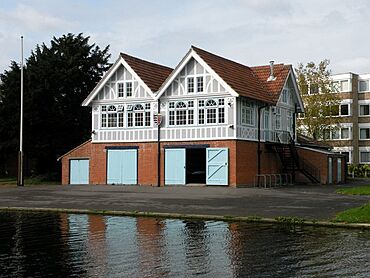
Pembroke College has both undergraduate (first degree) and graduate (advanced degree) students. They are all called Valencians, named after the college's original name. The student common rooms are called "parlours" instead of the usual "combination rooms." The undergraduate students are represented by the Junior Parlour Committee (JPC), and the graduate students by the Graduate Parlour Committee (GPC).
Students at Pembroke can join many sports teams and clubs. Some of the most well-known are the Pembroke College Boat Club and the Pembroke Players. The Pembroke Players is the college's drama group, famous for alumni like Peter Cook, Eric Idle, and Tim Brooke-Taylor. It has been active for over 67 years.
Pembroke College also has its own football teams for men (PCAFC) and women (PCWAFC) that compete against other colleges. The hockey club (PCHC) teams up with Christ's College. The rugby team, Pirton RUFC, is combined with Girton College.
Female undergraduate students were first allowed to join the college in 1984.
International Study Programmes
Pembroke is the only Cambridge college with an International Programmes Department. This department offers chances for international students to study in Cambridge for a semester (from mid-January to mid-June) or part of the summer. The Spring Semester Programme is a competitive program for excellent students who want to take regular Cambridge degree courses as full university members. About thirty students are accepted each year.
In the summer, the college offers the eight-week Pembroke Cambridge Summer Programme. Besides academic studies, students go on trips to places like London. The program also includes formal dinners and fun events like croquet games and punting on the River Cam. This program also awards the special Thouron Prize, which fully supports nine American undergraduate students from Harvard, Yale, and UPenn. Additionally, the Pembroke College, Cambridge 1976 Scholarship is given to three outstanding undergraduate students from the University of California.
Famous People from Pembroke College
Many famous people have studied or taught at Pembroke College. Here are just a few:
-
Nicholas Ridley, an English Protestant leader.
-
Edmund Spenser, a famous Elizabethan poet.
-
Lancelot Andrewes, an English bishop and Bible translator.
-
Roger Williams, a religious thinker and founder of Rhode Island in the USA.
-
William Pitt the Younger, who became the youngest British Prime Minister.
-
Sir George Gabriel Stokes, a brilliant mathematician and physicist.
-
Rab Butler, an important British politician.
-
Abba Eban, an Israeli Foreign Minister.
-
Harold Bloom, a well-known literary critic.
-
Peter Cook, a famous British comedian.
-
John Sulston, a British biologist and Nobel Prize winner.
-
Eric Idle, a British comedian and member of Monty Python.
-
Naomie Harris, a British actress.
-
Tom Hiddleston, a British actor.
| Name | Birth | Death | What they did |
|---|---|---|---|
| Trevor Allan | 1955 | Legal philosopher | |
| Lancelot Andrewes | 1555 | 1626 | Master of Pembroke; Bishop; helped translate the King James Bible |
| C.F. Andrews | 1871 | 1940 | Priest and activist for Indian independence |
| David Armitage Bannerman | 1886 | 1979 | Bird expert |
| Robert Bathurst | 1957 | Actor | |
| Richard Beard (author) | 1967 | Novelist and non-fiction writer | |
| Clive Betts | 1950 | British politician | |
| John Bradford | 1510 | 1550 | Teacher at Pembroke, later a martyr |
| Peter Bradshaw | 1962 | Author and film critic | |
| Tim Brooke-Taylor | 1940 | 2020 | Comedian, member of The Goodies |
| Marcus Buckingham | 1966 | Author and motivational speaker | |
| William Burkitt | 1650 | 1703 | New Testament commentator |
| Roger Bushell | 1910 | 1944 | Leader of "The Great Escape" |
| Rab Butler | 1902 | 1982 | British politician; served as Chancellor, Foreign Secretary, Home Secretary |
| Christopher Clark | 1960 | Professor of History at Cambridge | |
| Peter Cook | 1937 | 1995 | Comedian |
| Jo Cox | 1974 | 2016 | British aid worker and politician |
| Richard Crashaw | c.1613 | 1649 | Poet |
| William Crashaw | 1572 | 1626 | Anglican priest and poet |
| Seamus Deane | 1940 | 2021 | Novelist, poet and literary critic |
| Maurice Dobb | 1900 | 1976 | Economist |
| Simon Donaldson | 1957 | Mathematician; Fields Medallist (1986) | |
| Ray Dolby | 1933 | 2013 | Inventor who gave a large gift to Pembroke |
| C. H. Douglas | 1879 | 1952 | Engineer; pioneer of the Social Credit movement |
| Timothy Dudley-Smith | 1926 | Hymn writer and clergyman | |
| Abba Eban | 1915 | 2002 | Statesman; President of the Weizmann Institute of Science |
| Rick Edwards | 1979 | Television presenter | |
| Edward James Eliot | 1758 | 1797 | British politician |
| William Eliot, 2nd Earl of St Germans | 1767 | 1845 | British politician |
| Archibald Fargus | 1878 | 1963 | Cricketer, scholar, clergyman |
| Femi Fani-Kayode | 1960 | Former Nigerian Minister | |
| Roger W. Ferguson Jr. | 1951 | Economist, Vice Chairman of the U.S. Federal Reserve System | |
| Ian Fleming | 1935 | Organic chemist, professor | |
| William Fowler | 1911 | 1995 | Nobel Prize winner for Physics |
| Arthur Gilligan | 1894 | 1976 | England cricket captain |
| Alexander Grantham | 1899 | 1978 | Governor of Fiji, later Governor of Hong Kong |
| Thomas Gray | 1716 | 1771 | Poet |
| Stephen Greenblatt | 1943 | Literary critic | |
| Bendor Grosvenor | 1977 | Art historian | |
| Malcolm Guite | 1957 | Poet and author, priest | |
| Rupert Gwynne | 1871 | 1924 | Member of Parliament (MP) |
| Naomie Harris | 1976 | Actress | |
| Tom Harrisson | 1911 | 1976 | Ornithologist, anthropologist, soldier |
| Samuel Harsnett | 1561 | 1631 | Master, later Archbishop of York |
| Oliver Heald | 1954 | British politician | |
| Tom Hiddleston | 1981 | Actor | |
| Philip Hinchcliffe | 1944 | Television producer | |
| Ted Hughes | 1930 | 1998 | Poet |
| Eric Idle | 1943 | Comedian, member of Monty Python | |
| Clive James | 1939 | 2019 | Critic, journalist and broadcaster |
| Atma Jayaram | 1915 | 1990 | Former Director of Indian Intelligence Bureau |
| Peter Jeffrey | 1929 | 1999 | Actor |
| Humphrey Jennings | 1907 | 1950 | Film-maker |
| Bryan Keith-Lucas | 1912 | 1996 | Political scientist |
| Emma Johnson | 1966 | Clarinettist | |
| Leslie Peter Johnson | 1930 | 2016 | Germanist |
| Anna Lapwood | 1995 | Organist, conductor and broadcaster | |
| Robert Macfarlane | 1976 | Writer | |
| David MacMyn | 1903 | 1978 | Rugby union international player |
| Sir Henry James Sumner Maine | 1822 | 1888 | Lawyer and Historian |
| Peter May | 1929 | 1994 | Cricketer |
| Simon McDonald | 1961 | Diplomat | |
| D. H. Mellor | 1938 | 2020 | Philosopher |
| Messenger Monsey | 1694 | 1788 | Physician |
| Tom Morris | 1964 | Theatre director and producer | |
| Sir Allan Mossop | 1887 | 1965 | Chief Judge of the British Supreme Court for China |
| David Munrow | 1942 | 1976 | Musician, composer |
| Richard Murdoch | 1907 | 1990 | Actor, comedian |
| Bill Oddie | 1941 | Comedian, member of The Goodies, bird expert | |
| William Pitt | 1759 | 1806 | British Prime Minister |
| Rodney Porter | 1917 | 1985 | Nobel Prize winning Biochemist |
| George Maxwell Richards | 1931 | 2018 | President of Trinidad and Tobago |
| Nicholas Ridley | c. 1502 | 1555 | Bishop of London, martyr |
| Quintin Riley | 1905 | 1980 | Arctic explorer |
| Edmund Grindal | c. 1519 | 1571 | Archbishop of Canterbury |
| Michael Rowan-Robinson | 1942 | Astronomer and astrophysicist | |
| Martin Rowson | 1959 | Cartoonist | |
| Hugh Ruttledge | 1884 | 1961 | Mountaineer |
| Tom Sharpe | 1928 | 2013 | Novelist |
| Indra Sinha | 1950 | Novelist | |
| Christopher Smart | 1722 | 1771 | Poet, hymnist |
| Chris Smith, Baron Smith of Finsbury | 1951 | British politician; current Master | |
| Edmund Spenser | 1552 | 1599 | Poet |
| George Gabriel Stokes | 1819 | 1903 | Mathematician, physicist |
| John Sulston | 1942 | Chemist, Nobel Prize winner | |
| Peter Taylor, Baron Taylor of Gosforth | 1930 | 1997 | Lord Chief Justice |
| Peter Taylor | 1942 | Author and journalist | |
| Karan Thapar | 1955 | Writer, journalist, broadcaster | |
| William Turner | 1508 | 1568 | Physician |
| P. K. van der Byl | 1923 | 1999 | Rhodesian politician |
| Lawrence Wager | 1904 | 1965 | Geologist, explorer and mountaineer |
| Wavell Wakefield, 1st Baron Wakefield of Kendal | 1898 | 1983 | Rugby player |
| Leonard Whibley | 1864 | 1941 | Greek scholar |
| David White | 1961 | Garter Principal King of Arms | |
| Yorick Wilks | 1939 | Computer scientist, professor of artificial intelligence | |
| Roger Williams | 1603 | 1683 | Statesman, religious thinker, founder of Rhode Island |
| George Crichton Wells | 1914 | 1999 | Dermatologist |
| Ed Yong | 1981 | Science journalist and author | |
| Timothy Winter | 1960 | Academic, theologian and Islamic scholar |
Places Named After Pembroke College
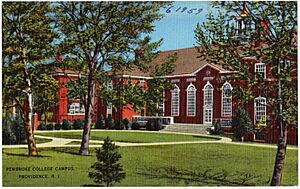
Pembroke College in Brown University, which used to be a women's college at Brown University in the United States, was named after Pembroke Hall. Pembroke Hall itself was named to honor Roger Williams, a former student of Pembroke College (Cambridge) and a founder of Rhode Island.
In 1865, Pembroke College, Cambridge, gave land to create a memorial in Suffolk for Prince Albert. This land in Framlingham was used to build a school called The Albert Memorial College. Today, this school is known as Framlingham College, and one of its houses is named Pembroke House to recognize Pembroke College's gift.
In 1981, after Pembroke College merged into Brown University, the Pembroke Center for Teaching and Research on Women at Brown was named in honor of Pembroke College. This name also celebrates the history of women's efforts to get access to higher education.
See also
 In Spanish: Pembroke College (Cambridge) para niños
In Spanish: Pembroke College (Cambridge) para niños
- Category:Fellows of Pembroke College, Cambridge
- List of organ scholars


